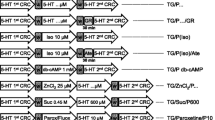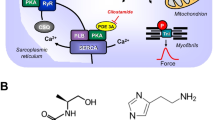Summary
The effects of 5-carboxamidotryptamine (5-CT) and the gastrokinetic benzamides renzapride and cisapride on contractile force were investigated using isolated paced right atrial appendages from patients treated with β-adrenoceptor blocking agents who were undergoing open heart surgery. These effects were compared to those of 5-hydroxytryptamine (5-HT). The effects of the drugs on atrial cyclic AMP levels and cyclic AMP-dependent protein kinase ratios were also investigated.
The drugs all increased contractile force rank order of potency was 5-HT > renzapride > cisapride > 5-CT. The maximum responses, expressed as a fraction of the response to 200 μmol/l (−)-isoprenaline, were 5-HT 0.6, 5-CT 0.6, renzapride 0.4 and cisapride ≥ 0.2, suggesting that the latter two are partial agonists. 5-HT, 5-CT and renzapride but not cisapride caused significant shortening of time to peak force. The effects of the four drugs were blocked by molar concentrations of ICS 205-930, suggesting an involvement of 5-HT4 receptors. As expected of partial agonists both renzapride and cisapride caused simple competitive antagonism of the positive inotropic effects of 5-HT The estimated equilibrium dissociation constants pK p (−log mol/l K p ) were 6.7 for renzapride and 6.2 for cisapride. 5-CT at concentrations up to 10 μmol/l did not antagonise the effects of 5-HT. In the presence of (±)-propranolol 0.4 μmol/I, 5-HT 10 μmol/l, 5-CT 100 μmol/I, renzapride 10 μmol/l and cisapride 40 μmol/I significantly increased cyclic AMP levels. 5-HT and renzapride also significantly increased cyclic AMP-dependent protein kinase activity, whereas 5-CT caused only marginal stimulation and cisapride was ineffective.
The results confirm the existence of a human right atrial 5-HT receptor that is similar in nature to, but not necessarily identical with, the 5-HT4 receptor of mouse embryonic colliculi neurones. The main difference is that in human right atrium the benzamides are less potent and efficacious than 5-HT and that cisapride is less potent and less efficacious than renzapride while in mouse embryonic colliculi these two benzamides are equipotent with and more efficacious agonists than 5-HT We designate the human right atrial 5-HT receptor 5-HT4-like. The human right atrial 5-HT4-like receptor greatly resembles porcine sinoatrial and left atrial 5-HT4-like receptors and also appears to be similar to 5-HT4-like receptors of guinea-pig ileum and rat oesophagus.
Similar content being viewed by others
References
Arunlakshana O, Schild HO (1959) Some quantitative uses of drug antagonism. Br J Pharmacol 14:48–58
Baxter GS, Clarke DE (1990) Putative 5-HT4 receptors mediate relaxation of rat oesophagus. Proceedings of the 2nd IUPHAR Satellite Meeting on Serotonin, Basel, Switzerland, July 11–13, abstract no. P85
Blinks JR (1965) Convenient apparatus for recording contractions of isolated muscle. J Appl Physiol 20:755–757
Bockaert J, Sebben M, Dumuis A (1990a) Pharmacological characterisation of 5-hydroxytryptamine4 (5-HT4) receptors positively coupled to adenylate cyclase in adult guinea pig hippocampal membranes: Effect of substituted benzamide derivatives. Mol Pharmacol 37:408–411
Bockaert J, Sebben M, Dumuis A (1990b) Inter-relationship between the interactions of 5-HT and benzamide derivatives on 5-HT4 receptors in brain. Second IUPHAR satellite meeting on serotonin, Basel, Switzerland, July 11–13, abstract 64
Bradford MM (1976) A rapid sensitive method for quantification of microgram quantities of protein utilising the principle of protein-dye binding. Anal Biochem 72:248–254
Craig DA, Clark DE (1990) Pharmacological characterisation of a neuronal receptor for 5-hydroxytryptamine in guinea pig ileum with properties similar to the 5-hydroxytryptamine4 receptor. J Pharmacol Exp Ther 252:1378–1386
Dumuis A, Bouhelal R, Sebben M, Cory R, Bockaert J (1988a) A nonclassical 5-hydroxytryptamine receptor positively coupled with adenylate cyclase in the central nervous system. Mol Pharmacol 34:880–887
Dumuis A, Bouhelal R, Sebben M, Bockaert J (1988b) A 5-HT receptor in the central nervous system positively coupled with adenylate cyclase is antagonized by ICS 205–930. Eur J Pharmacol 146:187–188
Dumuis A, Sebben M, Bockaert J (1989a) The gastrointestinal prokinetic benzamide derivatives are agonists at the non-classical 5-HT receptor (5-HT4) positively coupled to adenylate cyclase in neurons. Naunyn-Schmiedeberg's Arch Pharmacol 340:403–410
Dumuis A, Sebben M, Bockaert J (1989b) BRL 24924: a potent agonist at a non-classical 5-HT receptor positively coupled with adenylate cyclase in colliculi neurons. Eur J Pharmacol 162:381–384
Elswood CJ, Bunce KT, Humphrey PPA (1990) Identification of 5-HT4 receptors in guinea-pig ascending colon. Proceedings of the 2nd IUPHAR Satellite Meeting on Serotonin, Basel, July 11–13, abstract no. P86
Gille E, Lemoine H, Ehle B, Kaumann AJ (1985) The affinity of (−)-propranolol for β1- and β2-adrenoceptors of human hearts. Differential antagonism of the positive inotropic effects and adenylate cyclase stimulation by (−)-noradrenaline and (−)-adrenaline. Naunyn-Schmiedeberg's Arch Pharmacol 331:60–70
Kaumann AJ (1972) Potentiation of the effects of isoprenaline and noradrenaline by hydrocortisone in cat heart muscle. Naunyn-Schmiedeberg's Arch Pharmacol 273:134–153
Kaumann AJ (1990) Piglet sinoatrial 5-HT receptors resemble human atrial 5-HT4-like receptors. Naunyn-Schmiedeberg's Arch Pharmacol 342:619–622
Kaumann AJ, Lobnig BM (1986) Mode of action of (−)-pindolol on feline and human myocardium. Br J Pharmacol 89:207–218
Kaumann AJ, Sanders L, Brown AM, Murray KJ, Brown MJ (1989) A receptor for 5-hydroxytryptamine in human atrium. Br J Pharmacol 98:664 P
Kaumann AJ, Sanders L, Brown AM, Murray KJ, Brown MJ (1990a) A 5-hydroxytryptamine receptor in human atrium. Br J Pharmacol 100:879–885
Kaumann AJ, Sanders L, Brown AM, Murray KJ, Brown MJ (1990b) Human atrial 5-HT receptors: similarity to rodent neuronal 5-HT4 receptors. Br J Pharmacol 100:319 P
Kaumann AJ, Murray KJ, Brown AM, Frampton JE, Sanders L, Brown MJ (1990c) Heart 5-HT receptors. A novel 5-HT receptor in human atrium. In: Paoletti R, Vanhoutte P, Brunello N, Maggi FM (eds) Serotonin: From cell biology to pharmacology and therapeutics. Kluwers, Dordrecht, Boston, London, pp 347–354
Kaumann AJ, Brown AM, Raval P (1991) Putative 5-HT4-like receptors in piglet left atrium. Br J Pharmacol 102:98 P
Lemoine H, Kaumann AJ (1982) A novel analysis of concentration-dependence of partial agonism. Naunyn Schmiedeberg's Arch Pharmacol 320:130–144
Marano M, Kaumann AJ (1976) On the statistics of drug-receptor constants for partial agonists. J Pharmacol Exp Ther 198:518–525
Murray KJ, England PJ, Lynham JA, Mills D, Schmitz-Pfeiffer C, Reeves ML (1990) Use of a synthetic dodecapeptide (malantide) to measure the cyclic AMP-dependent protein kinase activity ratio in a variety of tissues. Biochem J 267:703–708
Villalon CM, Den Boer MO, Heiligers JPC, Saxena PR (1990) Mediation of 5-hydroxytryptamine-induced tachycardia in the pig by the putative 5-HT4 receptor. Br J Pharmacol 100:665–667
Villalon CM, Den Boer MO, Heiligers JPC, Saxena PR (1991) Further characterization, by use of tryptamine and benzamide derivatives, of the putative 5-HT4 receptor mediating tachycardia in the pig. Br J Pharmacol 102:107–112
Author information
Authors and Affiliations
Additional information
Send offprint requests to A. J. Kaumann at the above address
Rights and permissions
About this article
Cite this article
Kaumann, A.J., Sanders, L., Brown, A.M. et al. A 5-HT4-like receptor in human right atrium. Naunyn-Schmiedeberg's Arch Pharmacol 344, 150–159 (1991). https://doi.org/10.1007/BF00167212
Received:
Accepted:
Issue Date:
DOI: https://doi.org/10.1007/BF00167212




